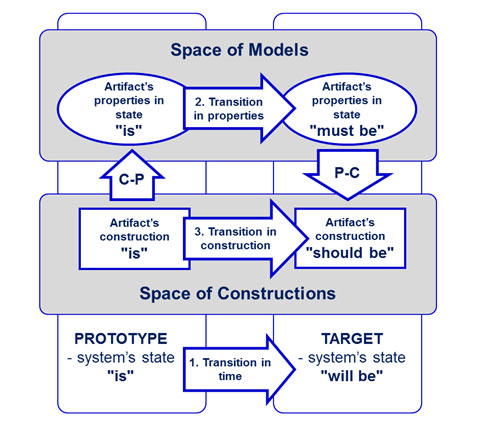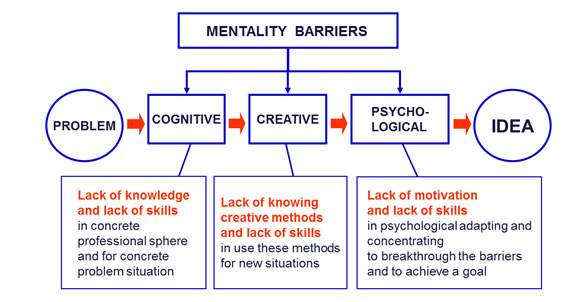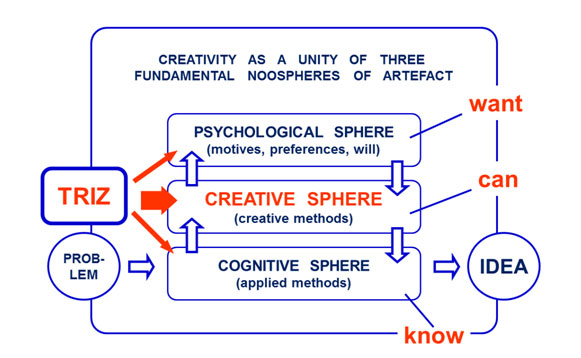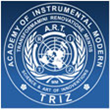TRIZ
It behooves me to emphasize from the outset:
our inventive problem-solving methodology
is not a recipe for making inventions.
The methodology does not replace,
or serve as a substitute for, technical knowledge.
It can only help use that knowledge with maximum efficiency.
Instead of randomly searching for answers
with huge expenditure of energy and time,
it offers a rational system.
Genrikh Saulowitsch Altshuller Founder of TRIZ




INVENTING THE IDEAS
The development of civilization took place on the basis of inventions. The invention of a new idea is not only to technical and technological evolution, but also to the social. The main creative method was and is brainstorming. This term I use for any method of intensification of creative thinking except TRIZ. Question: Is just this thinking in our time?
The development of civilization in our time becomes more technogenic and technocratic. Technical artifacts themselves are becoming more diverse and complex. Creation of new ideas for the development of technics and technologies requires more effective thinking. The new thinking must be even more intense. But most importantly, creative thinking should be more constructive. A new creative technology of effective thinking is needed, to link motivation with objective knowledge, and talent with the systematic management of inventive process.
An invention is the path from the available state of the artifact ("is") to a future state ("should be", or "needs to be") with the help of transformation models acting as thinking navigators.

Any invention involves three transitions:
1) transition in time: the prototype in the state "is" is modified in the required direction (in line with the specified trend) to arrive at the state "needs to be"; the trend is defined by the growing needs and restricted by available resources, including the informational resource – the sum total of knowledge required to create the new artifact;
2) transition in properties: while the prototype remains in the state "is", it al-ways has contradictions that need to be resolved; when its state changes to "needs to be" or "will be", those contradiction are eliminated;
3) transition in construction: in the state "is", the existing prototype construction fully determines all its properties (direction "Construction → Properties", or C-P); for the state "will be", it is necessary to create a new, currently unknown target construction which will have the required properties, i.e. the direction is changed to its opposite – P-C, or "Properties → Construction".
In terms of technical implementation, invention is a transition in construction.
In terms of systemic development, invention is a combination of three transitions: transition in properties, transition in construction, and transition in time.
This process can be described in more detail with the following chart.

Why a search for design ideas is too often so complex and problematic?
Complexity increase is defined by four main attributes. Two of those attributes are related to the formulation of the task, while the other two directly bear on its solution. In line with this differentiation, we recognize two levels of problem situations that we will be calling "manager problem" and "developer problem".

Transformation of a task into a problem is forced by its increasing complexity.

This situation can be called a "manager problem". Indeed, it is the managers, including the chief designer, that are responsible for the formulation of the problem and definition of the ultimate objective. Errors in this area are extremely costly. For example, wrong interpretation of competitor actions can directly lead to wasteful use of corporate resources to create products that will not be competitive a priori. The only solace is that eventually such products may find their niche in the market – but then again, this may never happen.

Description of the Cognitive "Barrier":
1. KNOWLEDGE IS IRREPLACEABLE (relevance condition): lack of specific knowledge regarding methods of modification of the object to achieve a certain desired outcome cannot be compensated by other means and abilities in most situations;
2. KNOWLEDGE IS INCOMPLETE (non-sufficiency condition): availability of knowledge, however complete, regarding methods of transformation of objects existing in a given applied sphere does not guarantee a "simple" logical identification (generation) of an efficient idea resolving a problem situation, as a minimum, because of the existence, in any such situation, of the two other "barriers".

Description of the Creative "Barrier":
1. CREATIVITY IS IRREPLACEABLE (relevance condition): lack of specific knowledge regarding methods of generation of creative ideas to achieve a certain desired outcome [almost] cannot be compensated by other means and abilities in complex, intricate situations which contain acute "irreconcilable" contradictions;
2. CREATIVITY IS MOTIVATED (non-sufficiency condition): availability of knowledge and skills required to generate creative ideas does not guarantee "automatic" synthesis of an efficient idea to resolve a specific problem situation, as a minimum, because of insufficient motivation and volition, i.e. because of the existence of the psychological "barrier".
Note: the bracketed word "almost" (as used above and below) means that in certain relatively simple situations, and subject to certain special conditions, there have been precedents of "insights" and "visions" producing ideas for solutions. To all intents and purposes, practical replication of such conditions is impossible.
Description of the Psychological "Barrier":
1. MOTIVATIONAL DOMINANT (relevance condition): lack of willingness to attain the objective cannot be compensated by other means and abilities;
2. EQUIPPED DOMINANT (sufficiency condition):
- availability of creative modeling and idea generation knowledge and skills in-creases personal confidence and motivation to invent efficient solutions;
- availability of psychological self-regulation knowledge and skills increases personal sustainability and successfulness in generating efficient ideas in situations with "irresolvable" problems.
To overcome the above "barriers", one has to first acquire knowledge and skills in the "three spheres of creative excellence" which contribute to successful resolution of complex problems.
it is necessary to:
1) KNOWLEDGE: continuously improve general and specialized knowledge and skills in the selected professional area,
2) CREATIVE SKILL: continuously improve creative problem resolution and efficient ideas generation knowledge and skills in the areas of creative problem resolution and generation of efficient ideas,
3) MOTIVATION: continuously improve knowledge and skills in the area of self-control and self-management with a view to be able to mobilize individual psychological resources at the requisite time in the requisite place ("here and now").

Creative excellence in these three spheres metaphorically corresponds to the well-known triad:
Know + Can (Be Able) + Want
Today, after several decades of experience, we have the right to state with full responsibility that just TRIZ and only TRIZ can be the Theory of Invention, and what's more, in the not so long term, and with a corresponding development - Theory of Creativity.

